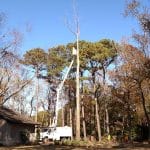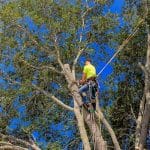As a certified arborist, I am most frequently called to remove trees and limbs throughout the Lowcountry, including the Charleston and Mount Pleasant areas. Less frequently I am called as a consultant to assist homeowners to beautify their existing flowering trees. After days of helping with damaged trees, these calls from people with questions about their flowering tree health make my week the most enjoyable. Trimming and pruning live oaks and other grand trees allows me to use the arborist skills I have plied for over two decades, but delicate flowering tree care is like a breath of fresh air. The results are immediate.
While flowers, especially those on trees around the Charleston, SC area, are indeed very beautiful, one has to admit that some flowering trees are far more beautiful than others. In fact, some of these trees are known to create an entirely different mood and convey a breathtaking essence – just from their mere presence. Such trees possess the capability to transform the garden – to provide a scene that shows beauty, life and grandeur, guaranteed to entice the saddest of souls into getting out and taking in the beauty of the season. From Summerville to the barrier islands of Isle of Palms, Kiawah Island and Sullivan’s Island, these beautiful trees can make the entire home site burst with color.
That is not all, though. The flowers of flowering trees attract pollinators, while their fruits attract small mammals and birds. As they change with the season, they add a new touch and essence to the garden, and naturally change its look. Here are a few trees that you can plant in your garden landscape to transform it into the natural wonderland you have always dreamed of. Drive through Mount Pleasant neighborhoods on a weekend that you have free to see how homeowners adorn their property.
Below are a few of my favorite small and medium sized trees that provide brilliant color.
1. Crape Myrtle (or Crepe Myrtle)
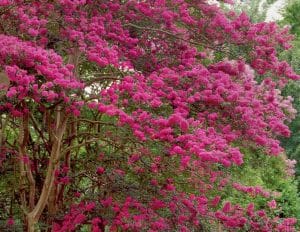 You will see these in roughly one of ten home sites in the Charleston area. Known for their tolerance to relatively extreme conditions, crape myrtles are known for their ever-changing features, and multiple and exfoliating barks. In the summer months, these display flower panicles that are dense and cloudlike in structure and white, red, pink, or purple in color. During this time, the tree might resemble a grove, thanks to the multiple-colored flowers and multiple trunks. The paper-thin barks peel away during the summer, only to reveal trunks that instead look mottled and polished.
You will see these in roughly one of ten home sites in the Charleston area. Known for their tolerance to relatively extreme conditions, crape myrtles are known for their ever-changing features, and multiple and exfoliating barks. In the summer months, these display flower panicles that are dense and cloudlike in structure and white, red, pink, or purple in color. During this time, the tree might resemble a grove, thanks to the multiple-colored flowers and multiple trunks. The paper-thin barks peel away during the summer, only to reveal trunks that instead look mottled and polished.
While crape myrtles grow well irrespective of the weather (they are known to grow as a dieback plant in colder areas), they do flower their best during the hot summer season, when they are seen to grow up to 15 to 25 feet tall. More than half of the Mount Pleasant homeowners incorrectly severely prune these trees.
2. Redbud
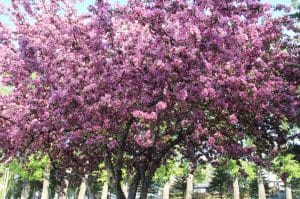 Known as the harbinger of spring, the redbud has glowing magenta flowers which can give a beautiful, fiery appearance to any given garden. These flowers remain up to 3 weeks after which they give way to big, heart-shaped leaves emerge. Originally native to the wild North American landscape, these trees are surprisingly suitable for formal settings, in groves and as specimens. Sporting bright yellow foliage, redbuds grow up to 25 feet in height, though they do end up stooping with time and age. I had one that produced wonderful magenta leaves but was severely damaged during a hurricane. Part survived and another shoot grew out of the damage. The new shoot produced another tree that did not produce magenta leaves.
Known as the harbinger of spring, the redbud has glowing magenta flowers which can give a beautiful, fiery appearance to any given garden. These flowers remain up to 3 weeks after which they give way to big, heart-shaped leaves emerge. Originally native to the wild North American landscape, these trees are surprisingly suitable for formal settings, in groves and as specimens. Sporting bright yellow foliage, redbuds grow up to 25 feet in height, though they do end up stooping with time and age. I had one that produced wonderful magenta leaves but was severely damaged during a hurricane. Part survived and another shoot grew out of the damage. The new shoot produced another tree that did not produce magenta leaves.
3. Seven-son Flower
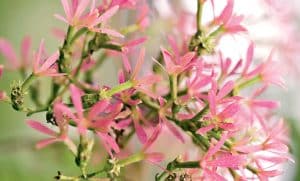 This flower, which is originally from China and blooms between late summer and early fall, is known for its fresh and long-lasting snow-white blossoms. It has an exfoliating bark, for which it is often called the crape myrtle of the North. The most striking feature of the seven-son flower, however, is its pinkish red calyxes which remain for weeks after the flowers fade. This extremely salt- and drought-tolerant flower blooms equally well in sun and shade and grows up to 15 to 20 feet in height.
This flower, which is originally from China and blooms between late summer and early fall, is known for its fresh and long-lasting snow-white blossoms. It has an exfoliating bark, for which it is often called the crape myrtle of the North. The most striking feature of the seven-son flower, however, is its pinkish red calyxes which remain for weeks after the flowers fade. This extremely salt- and drought-tolerant flower blooms equally well in sun and shade and grows up to 15 to 20 feet in height.
4. Fringe Tree
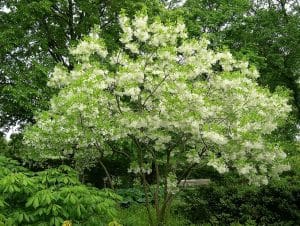 Old-fashioned and reminiscent of an old-world, earthy look, fringe trees are known for their tassel-like, wispy flowers, which can be found hanging among the branches in the middle of spring. These trees are often planted in groves and grow up to 10 to 20 feet in height. Resistant to normal weather changes, fringe trees grow well in the sun as well as in partial shade. It is a good idea to plant these trees in groves, with the male and female trees all mixed-up. This is because the male fringe trees flower robustly, while the female trees produce small fruits that birds find very attractive.
Old-fashioned and reminiscent of an old-world, earthy look, fringe trees are known for their tassel-like, wispy flowers, which can be found hanging among the branches in the middle of spring. These trees are often planted in groves and grow up to 10 to 20 feet in height. Resistant to normal weather changes, fringe trees grow well in the sun as well as in partial shade. It is a good idea to plant these trees in groves, with the male and female trees all mixed-up. This is because the male fringe trees flower robustly, while the female trees produce small fruits that birds find very attractive.
5. Flowering Dogwood
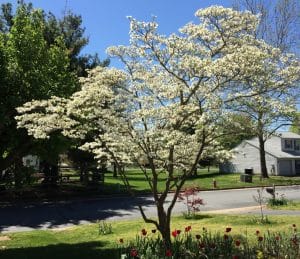 One of my favorites, but the color is short lived. Watch the Masters Golf tournament to see superb dogwoods of varying colors, but only if the tournament catches the couple weeks of bloom. If you are dying to breathe some new life into your garden, the flowering dogwood is just the flower for you. Well-known among cultivars as “a super-attractive bird tree,” the dogwood has beautiful snow-white blossoms, which turns into bright red berries with the passage of time. Unfortunately, they are rather delicate, and require specific conditions to grow properly. This includes moderate sun and shade, good quality air circulation and drainage.
One of my favorites, but the color is short lived. Watch the Masters Golf tournament to see superb dogwoods of varying colors, but only if the tournament catches the couple weeks of bloom. If you are dying to breathe some new life into your garden, the flowering dogwood is just the flower for you. Well-known among cultivars as “a super-attractive bird tree,” the dogwood has beautiful snow-white blossoms, which turns into bright red berries with the passage of time. Unfortunately, they are rather delicate, and require specific conditions to grow properly. This includes moderate sun and shade, good quality air circulation and drainage.
6. Flowering Crabapple
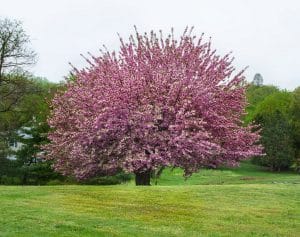 Reliable, hardy trees that are small in size and look good in small batches, crabapples are available in 700 different named varieties. Excellent wildlife trees, they are massively attractive for bees, birds and other pollinators. They grow up to 15-25 feet in height and often sport a stately and dramatic structure. During the spring season, crabapples have scores of multiple-colored flowers blooming on their branches. I have had a crabapple tree completely blow over in a hurricane but was able to pull it upright and stabilize with cables. It continues to flower two decades after.
Reliable, hardy trees that are small in size and look good in small batches, crabapples are available in 700 different named varieties. Excellent wildlife trees, they are massively attractive for bees, birds and other pollinators. They grow up to 15-25 feet in height and often sport a stately and dramatic structure. During the spring season, crabapples have scores of multiple-colored flowers blooming on their branches. I have had a crabapple tree completely blow over in a hurricane but was able to pull it upright and stabilize with cables. It continues to flower two decades after.
7. Sweetbay Magnolia
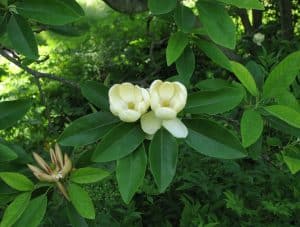 Particularly popular among gardeners in the South, this Southern native is a surprisingly hardy tree that grows equally well in the summer and the winter. In fact, it is known to bloom in the harsh winter climates of Chicago and north Boston. The tree has small, cream-colored, goblet-shaped flowers which look beautiful and leave a sweet fragrance, and glossy leaves, whose undersides are silvery in color. The tree has two variations – M. virginiana var. australis (the southern form), which is evergreen and tall, and M. virginiana (the northern form), which is deciduous and has multiple trunks. Tolerant to drought and moist soils, the Sweetbay Magnolia grows up to 10-20 feet in the north, and sometimes even taller in the south.
Particularly popular among gardeners in the South, this Southern native is a surprisingly hardy tree that grows equally well in the summer and the winter. In fact, it is known to bloom in the harsh winter climates of Chicago and north Boston. The tree has small, cream-colored, goblet-shaped flowers which look beautiful and leave a sweet fragrance, and glossy leaves, whose undersides are silvery in color. The tree has two variations – M. virginiana var. australis (the southern form), which is evergreen and tall, and M. virginiana (the northern form), which is deciduous and has multiple trunks. Tolerant to drought and moist soils, the Sweetbay Magnolia grows up to 10-20 feet in the north, and sometimes even taller in the south.
8. American Yellowwood
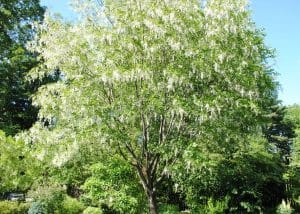 If you are looking for a plant that will turn your garden into a mesmerizing spectacle, look no further than the American Yellowwood. Originally a native of the wild parts of the Midwest and mid-Atlantic areas, the plant looks especially elegant when it grows against a background of conifers. Ironically, the yellowwood is barely found the wild these days.
If you are looking for a plant that will turn your garden into a mesmerizing spectacle, look no further than the American Yellowwood. Originally a native of the wild parts of the Midwest and mid-Atlantic areas, the plant looks especially elegant when it grows against a background of conifers. Ironically, the yellowwood is barely found the wild these days.
Known for its elegance, the yellowwood has drooping, fragrant white flower panicles, and a bark whose smoothness and silvery look stands only second to beech. The plant, which blooms during early summer, only blooms once the trees have reached a height of at least twelve feet. The foliage turns yellow during the fall. Over the course of a few years, the yellowwood grows up to 30-50 feet in height and has a wider spread.
9. Chaste Tree
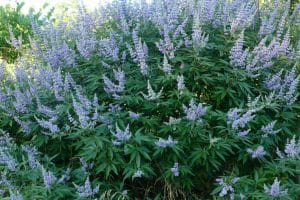 If you are the type of person who is not too keen on taking care of your plants on a daily basis, this is a good choice for you. Known to grow in areas with harsh sun and almost no water, the Chaste tree blooms in August in the Pacific Northwest, and in June in the South. The plant’s flowers bloom in the form of luminous lavender spikes, which appear on 6-inch-long wands above gray-green-colored foliage, and make for a look that is lively and elegant, especially during the late-summer season.
If you are the type of person who is not too keen on taking care of your plants on a daily basis, this is a good choice for you. Known to grow in areas with harsh sun and almost no water, the Chaste tree blooms in August in the Pacific Northwest, and in June in the South. The plant’s flowers bloom in the form of luminous lavender spikes, which appear on 6-inch-long wands above gray-green-colored foliage, and make for a look that is lively and elegant, especially during the late-summer season.
The size of the Chaste tree, however, is known to vary – while they are known to grow up to about twenty feet tall and equally wide in the South, the ones that grow in the Pacific Northwest barely grow up to half of that size. Like many others of its kind, the chaste tree grows as a dieback plant in colder climates.
Last modified: August 22, 2023


